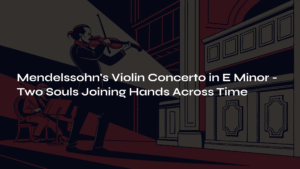Table of Contents

One Step, Then Another – Carving a Song of Silence
Some music makes us feel silence more deeply than sound itself. Claude Debussy’s “Des pas sur la neige” (Footsteps in the Snow) is precisely such a piece. This small prelude of barely three minutes invites us not into sound, but into the spaces between sounds.
From the moment the first note resonates, we understand. This is not merely a piano piece, but an intimate diary of someone walking alone across winter fields. The repetitive D-E, E-F rhythm created by the left hand is as regular as footsteps on frozen ground, yet weighted with solemnity. The melody that flows above from the right hand drifts like thoughts arising with each step, fragments of memories both tender and melancholy.
Each time I listen to this piece, premiered in Paris in 1910, I’m reminded of those emotions we can truly confront only in solitude. Debussy insisted this work should be performed “entre quatre-z-yeux” – between four eyes, in the most private and intimate of spaces. As if we were secretly glimpsing someone’s personal diary.
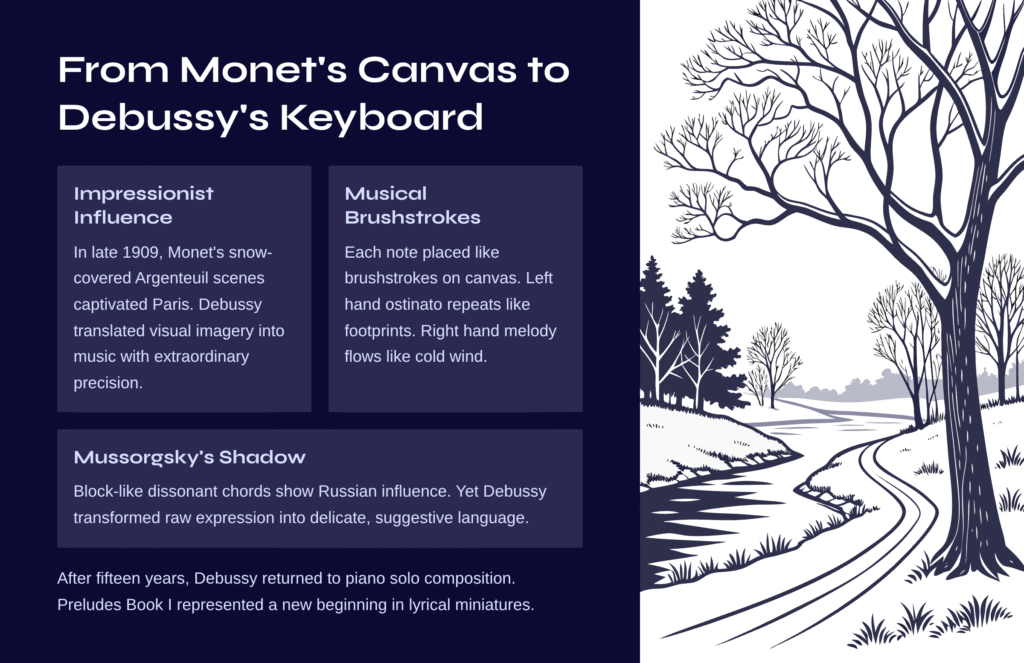
From Monet’s Canvas to Debussy’s Keyboard
Winter Painted by Impressionist Masters, Silence Heard by a Musician
In late 1909, when Debussy composed this piece, Impressionist painters’ winter landscapes were gaining enormous popularity in Paris. Works like Claude Monet’s snow-covered Argenteuil scenes or Alfred Sisley’s “Snow at Louveciennes” captured the imagination. White canvases dotted with gray and purple shadows, crossed by the faintest trace of footprints.
Debussy possessed an extraordinary gift for translating such visual imagery into music. In “Des pas sur la neige” especially, each note is placed with the precision of brushstrokes on canvas. The left hand’s ostinato repeats like footprints marked at regular intervals across snow, while the right hand’s melody flows like cold wind across the surface.
Mussorgsky’s Shadow and Debussy’s Colors
This piece harbors another influence: the inspiration drawn from Russian composer Mussorgsky. We can trace this particularly in the “block-like dissonant chords” that appear in the middle section. Yet Debussy transformed Mussorgsky’s raw, direct expression into his own delicate, suggestive language.
For Debussy, returning to piano solo composition after fifteen years, this Preludes Book I represented a new beginning. No longer pursuing grand forms like sonatas or variations, he turned toward the world of lyrical miniatures that expressed his inner feelings with unprecedented honesty.
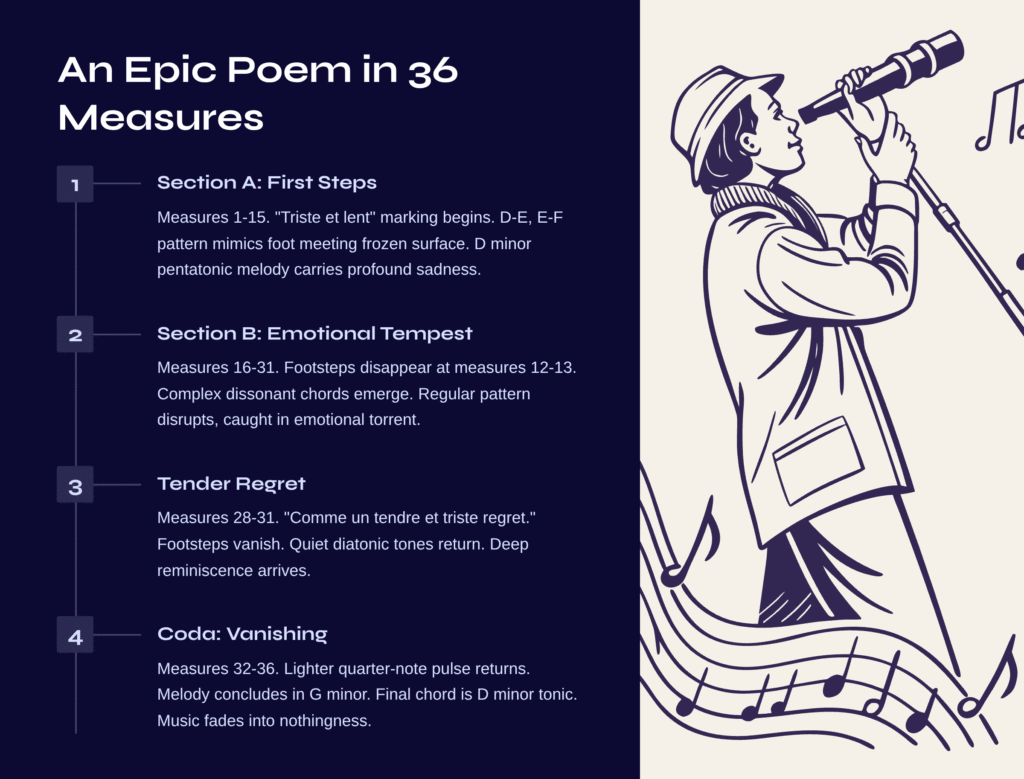
An Epic Poem in 36 Measures
Section A: First Steps and Rising Memories (measures 1-15)
The piece begins with the marking “Triste et lent” (sad and slow). Debussy wrote directly on the score: “This rhythm should have the sonorous value of a sad and frozen landscape.”
The opening fifteen measures feel like someone taking their first steps into a winter field. The left hand’s D-E, E-F pattern begins with dotted rhythms that perfectly mimic the weight of foot meeting frozen surface, followed by the lighter movement forward. As musicologist Siglind Bruhn observed, it’s the rhythm of right foot and left foot alternately pressing into snow.
From the right hand emerges a poignant melody based on the D minor pentatonic scale. Though extremely simple, this melody carries profound sadness and longing within its simplicity. Like memories that surface during a solitary walk.
Section B: Emotional Tempest and Deep Meditation (measures 16-31)
As we enter the middle section, the music transforms dramatically. At measures 12-13, the footsteps momentarily disappear – the protagonist has paused, lost in thought. From measure 16, far more complex dissonant chords emerge, leading to the piece’s emotional climax.
Here the footstep rhythm changes dramatically. The regular pattern becomes disrupted, as if caught in an emotional torrent. Musicologist Michael Oravitz describes this moment as “a concentrated thinking moment requiring the expenditure of emotional energy.” Perhaps the protagonist confronts some painful memory or loss.
Reaching measures 28-31, Debussy marks “Comme un tendre et triste regret” (like a tender and sad regret). Here the footsteps vanish again, and a moment of deep reminiscence arrives. The quiet diatonic tones from earlier return as the protagonist sinks deeper into inner contemplation.
Coda: Vanishing Footsteps and Eternal Silence (measures 32-36)
In the final five measures, footsteps return but now in a more practical quarter-note pulse. Unlike the heavy half-note stamps of earlier, these are lighter steps. Perhaps the protagonist has completed deep meditation and emerged onto a more traveled path.
But the true beauty of this piece lies in its ending. The melody concludes in G minor, yet the final chord is the tonic of D minor. With markings “morendo” (dying away) and “ppp” (very soft), the music doesn’t resolve but simply fades into nothingness. As if footprints, memories, everything dissolves into snow.

Step by Step: An Inner Monologue
Winter Walking as Meditative Act
Listening to this piece, I often recall solitary winter walks. Those moments when cold air penetrates deep into the lungs and snow crunches underfoot. In such moments, we encounter aspects of ourselves usually hidden from consciousness.
Debussy’s “Des pas sur la neige” captures exactly such an experience in music. Rather than merely depicting winter scenery, it portrays a human being confronting themselves through the act of solitary walking. Each footstep is a thought, each pause a realization, each breath a sigh.
Learning to Hear the Inaudible
In this piece, silence matters more than sound. The spaces between notes, the gaps between phrases, and finally the absolute stillness at the end. Through such silences, Debussy conveys emotions beyond words.
The texture consists almost entirely of three layers: left hand ostinato bass (footsteps), middle voice harmonies, and right hand melody. The dialogue these three layers create resembles multiple voices conversing within one person’s inner world.

Painting Winter Landscapes with Sound – Listening Guide
First Listen: Following the Footstep Rhythm
When first encountering this piece, focus on the left hand’s footstep rhythm. Listen how the D-E, E-F pattern that permeates the entire piece evolves. Beginning with dotted rhythms, changing in the middle, then returning in different form at the end – like following a walking journey.
Pay special attention to moments when footsteps disappear. At measures 12-13 and 28-31, when rhythm ceases, the protagonist has paused in contemplation. In such moments, music paints inner landscapes with pure harmony and melody alone.
Second Listen: Hearing Layered Voices
On your second listening, notice how the three layers dialogue with each other. Above the left hand’s footsteps, harmonies ring from the middle voices, while the right hand’s melody flows above. Sometimes melody leads, sometimes harmony dominates, sometimes the footstep rhythm itself comes to the fore.
In the middle section (measures 16-24), these three layers interweave complexly, creating an emotional whirlpool. Here, simply surrender to the musical flow and feel the emotional transformations.
Third Listen: The Aesthetics of Silence and Dissolution
For your third listening, pay particular attention to how the music ends. Rather than providing clear closure like most pieces, it simply fades away. This captures the essence of Debussyan Impressionist music.
Listening to those final moments marked “morendo” and descending to “ppp,” imagine footprints in snow soon to be covered by fresh snowfall. All is temporary, all emotion fleeting, all memory eventually dissolving into time – this short piece contains these profound truths about existence.

Various Winter Stories from Different Performers
Michelangeli’s Structural Clarity
Arturo Benedetti Michelangeli’s 1978 recording stands as the benchmark for this piece. In his performance, the three layers are distinctly separated, each role clearly audible. Michelangeli’s characteristic flat-finger technique proves especially effective in sustained legato passages, his multi-layered articulation breathing life into static harmonic structures.
His performance reveals the piece’s narrative structure perfectly without being swept away by emotion. I strongly recommend this version for first-time listeners.
Gieseking’s Impressionist Colors
Walter Gieseking’s performance is legendary in Debussy interpretation. In his playing, each chord’s color lives and breathes, offering subtle timbral changes like brushstrokes in Impressionist painting. Gieseking demonstrates exceptional pedaling technique, allowing harmonies to spread naturally while maintaining exquisite balance.
Uchida’s Intellectual Approach
Mitsuko Uchida’s performance features delicate, intellectual interpretation. She analyzes each section’s musical events with great care, particularly clarifying harmonic changes and subtle tonal shifts. Her performance achieves excellent balance between emotional expression and structural clarity.
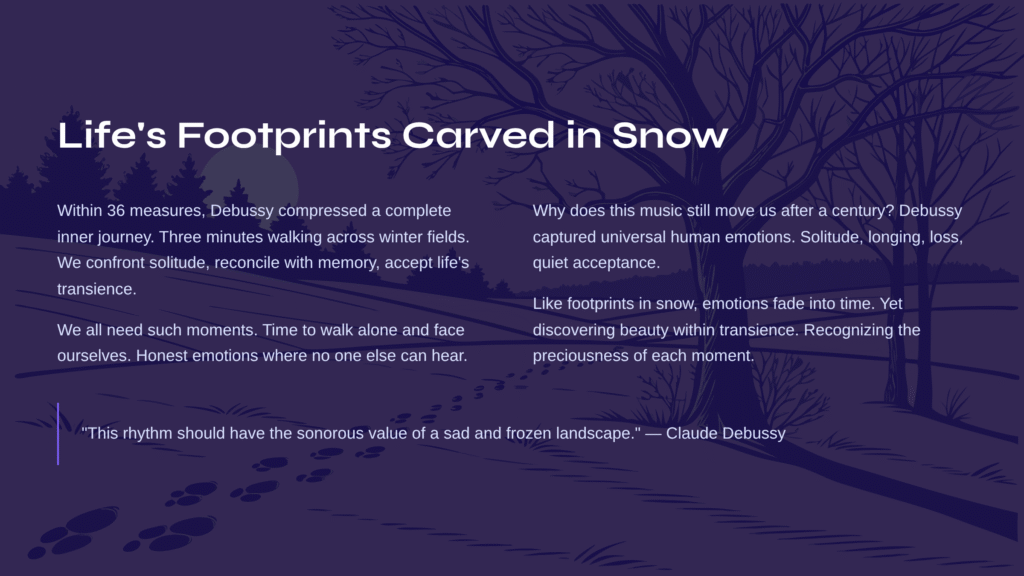
Life’s Footprints Carved in Snow
Within the extremely concise form of 36 measures, Debussy compressed a complete inner journey. During those three-plus minutes of walking alone across winter fields, we confront solitude, reconcile with memory, and ultimately accept life’s transience.
Listening to this music, I reflect on how we all need such moments. Time to walk alone and face ourselves, moments to feel honest emotions where no one else can hear. Debussy’s “Des pas sur la neige” is like a treasure chest preserving exactly such precious moments in musical form.
Why does this music still move us after more than a century? Perhaps because Debussy perfectly captured those universal human emotions – solitude, longing, loss, and the quiet acceptance that embraces them all.
Like footprints in snow, all our emotions eventually fade into time. Yet discovering beauty within that transience, helping us recognize the preciousness of each moment – this is the greatest gift this small prelude offers us.
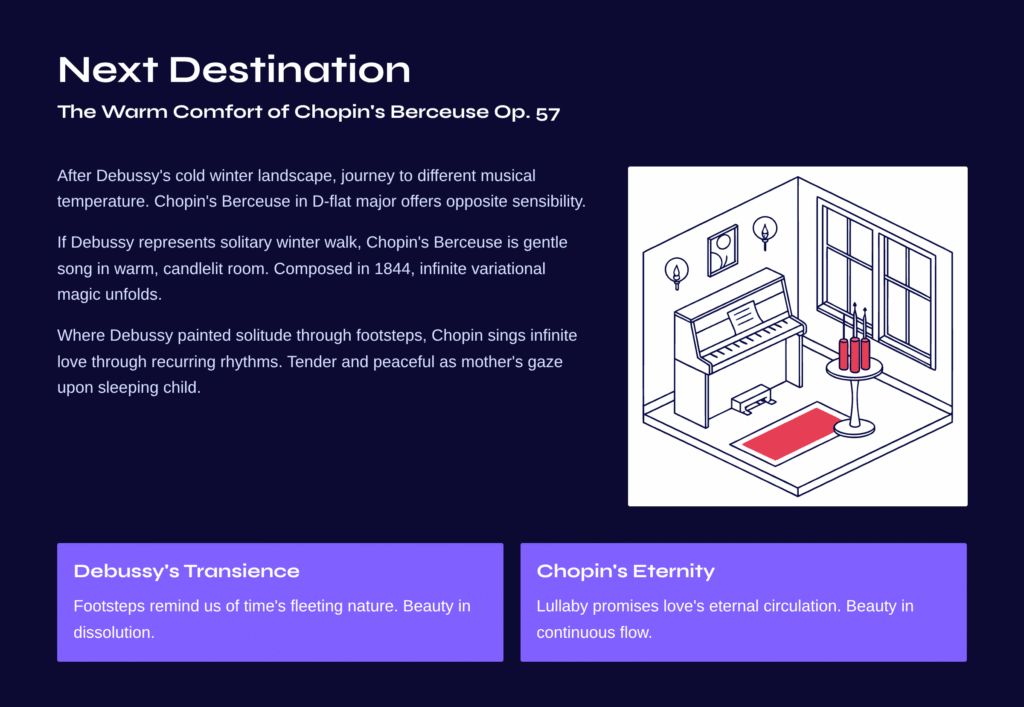
Next Destination: The Warm Comfort of Chopin’s Berceuse Op. 57
Having fully immersed yourself in Debussy’s cold winter landscape, why not journey to an entirely different musical temperature? Chopin’s Berceuse in D-flat major, Op. 57 offers a sensibility completely opposite to Debussy’s “Footsteps in the Snow.”
If Debussy’s prelude represents a solitary winter walk, Chopin’s Berceuse is a gentle song sung for a beloved in a warm, candlelit room. Composed in 1844, this work unfolds infinite variational magic within a single tonality (D-flat major).
Where Debussy painted solitude and reflection through footsteps in snow, Chopin sings of infinite love and protection through the berceuse’s recurring rhythms. The variations flowing over the left hand’s steady accompaniment pattern are as tender and peaceful as a mother’s gaze upon her sleeping child.
After experiencing the aesthetics of silence and dissolution in “Footsteps in the Snow,” now feel the beauty of continuous flow and eternal circulation. Both works use repetition, but with completely different meanings. While Debussy’s footsteps remind us of time’s transience, Chopin’s lullaby promises love’s eternity.



